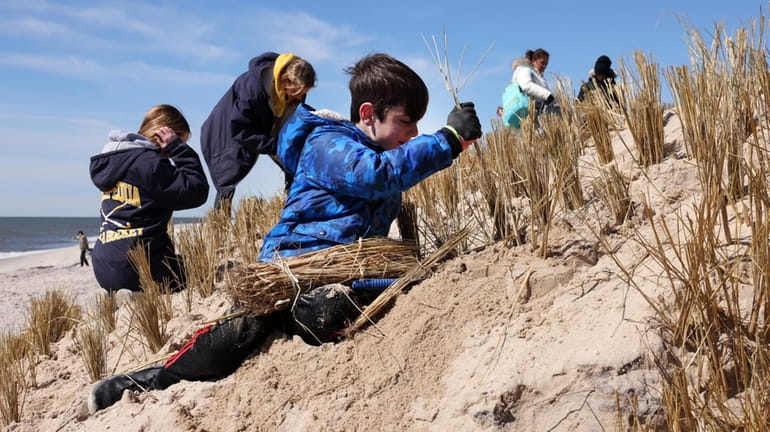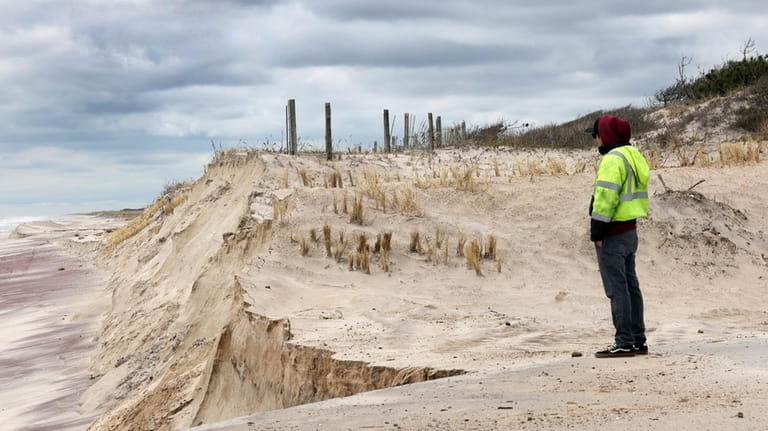'Devastating': Volunteers planted dune grass at Tobay Beach. Days later, it was gone

Andrew Lepsis, 10, of West Islip, was among volunteers who planted new dune grass at Tobay Beach on March 30 before a storm washed it away days later. Andrew's grandmother, Maria Rizzi, said after the storm she was undeterred and would bring even more family members back to the beach for another such effort. Credit: Debbie Egan-Chin
Since Cynthia Florio was a lifeguard at Tobay Beach in the 1990s, she has watched the ocean encroach on the shore and draw closer to the dunes.
It's what compelled Florio, 53, of Massapequa, to take part in the Town of Oyster Bay’s annual dune grass planting event on March 30 — an effort to help stabilize the beach dunes against shoreline erosion.
But four days later, a storm on Wednesday battered Long Island and washed the new plants away.
Along with other volunteers, Florio had spent hours with her daughter, Kyra Florio-Marinello, 15, and her daughter's friend Tatum Brennan, 15, planting stalks of the native plants that were intended to absorb water and brace the sand against heavy wind.
“It's absolutely devastating,” Florio told Newsday on Thursday. “It just goes to show how much work we need to do to prevent this from happening.”
The latest dune planting event drew more than 150 volunteers who planted four pallets of stalks across 2.7 acres of Atlantic Ocean sand dunes, said Marta Kane, an Oyster Bay spokeswoman. The dune grass cost the town $32,000.
The event, centered on volunteerism, drew some families whose elders were looking to share a message with a younger generation about the importance of protecting the environment. While the aftermath triggered a wave of disappointment, for some volunteers that was coupled with a sense of renewed motivation.
Maria Rizzi, 70, of Massapequa, participated in the planting session with her grandson, Andrew Lepsis, 10.
When she learned of what she called the “upsetting” level of erosion days later, Rizzi was undeterred. She said she would go back for another event with even more family members in tow.
“I'd be willing to do it again,” she said. “I'd even talk the older grandkid into coming.”
Oyster Bay Supervisor Joseph Saladino said the town has spent $4.2 million in the past two years buying 66,000 tons of sand to replenish the shoreline. Saladino previously called on the federal government to assist with fighting erosion on the town's South Shore.
A day after last week's storm, he said the beach was in bad shape.
“There are no more dunes in most of the places,” Saladino said during a phone interview from the beach. “Waves are literally breaking under the main pavilion of Tobay Beach and it's low tide.”
Allison Branco, director of climate adaptation for the New York branch of nonprofit The Nature Conservancy, said the timing of the storm was unfortunate, but the damage doesn't nullify the effectiveness of dune grass planting as a prong to battling beach erosion.
The dunes were effective in absorbing wave energy and protecting nearby infrastructure, including Ocean Parkway, Branco said, even if the storm's presence just days after the planting event made it unlikely the grass had fully taken root.
“Ideally, when you plant dune grass you want it to have the time to grow … and help hold the sand stable,” Branco said.
While the storm swept the new plantings away, Florio said Tobay Beach's appearance in the aftermath serves as a powerful reminder of the need for more volunteer work on that stretch of sand.
“Maybe it will inspire more people to volunteer and understand the need for us to protect our beaches,” Florio said.
Since Cynthia Florio was a lifeguard at Tobay Beach in the 1990s, she has watched the ocean encroach on the shore and draw closer to the dunes.
It's what compelled Florio, 53, of Massapequa, to take part in the Town of Oyster Bay’s annual dune grass planting event on March 30 — an effort to help stabilize the beach dunes against shoreline erosion.
But four days later, a storm on Wednesday battered Long Island and washed the new plants away.
Along with other volunteers, Florio had spent hours with her daughter, Kyra Florio-Marinello, 15, and her daughter's friend Tatum Brennan, 15, planting stalks of the native plants that were intended to absorb water and brace the sand against heavy wind.
“It's absolutely devastating,” Florio told Newsday on Thursday. “It just goes to show how much work we need to do to prevent this from happening.”
The latest dune planting event drew more than 150 volunteers who planted four pallets of stalks across 2.7 acres of Atlantic Ocean sand dunes, said Marta Kane, an Oyster Bay spokeswoman. The dune grass cost the town $32,000.
The event, centered on volunteerism, drew some families whose elders were looking to share a message with a younger generation about the importance of protecting the environment. While the aftermath triggered a wave of disappointment, for some volunteers that was coupled with a sense of renewed motivation.
Maria Rizzi, 70, of Massapequa, participated in the planting session with her grandson, Andrew Lepsis, 10.
When she learned of what she called the “upsetting” level of erosion days later, Rizzi was undeterred. She said she would go back for another event with even more family members in tow.
“I'd be willing to do it again,” she said. “I'd even talk the older grandkid into coming.”

Erosion is seen in an area of Tobay Beach where volunteers recently planted dune grass that was washed away in a storm days later. Credit: Debbie Egan-Chin
Oyster Bay Supervisor Joseph Saladino said the town has spent $4.2 million in the past two years buying 66,000 tons of sand to replenish the shoreline. Saladino previously called on the federal government to assist with fighting erosion on the town's South Shore.
A day after last week's storm, he said the beach was in bad shape.
“There are no more dunes in most of the places,” Saladino said during a phone interview from the beach. “Waves are literally breaking under the main pavilion of Tobay Beach and it's low tide.”
Allison Branco, director of climate adaptation for the New York branch of nonprofit The Nature Conservancy, said the timing of the storm was unfortunate, but the damage doesn't nullify the effectiveness of dune grass planting as a prong to battling beach erosion.
The dunes were effective in absorbing wave energy and protecting nearby infrastructure, including Ocean Parkway, Branco said, even if the storm's presence just days after the planting event made it unlikely the grass had fully taken root.
“Ideally, when you plant dune grass you want it to have the time to grow … and help hold the sand stable,” Branco said.
While the storm swept the new plantings away, Florio said Tobay Beach's appearance in the aftermath serves as a powerful reminder of the need for more volunteer work on that stretch of sand.
“Maybe it will inspire more people to volunteer and understand the need for us to protect our beaches,” Florio said.
Erosion battle at Tobay Beach
- The Town of Oyster Bay held a dune grass planting event for volunteers on March 30.
- A storm four days later washed away the dune grass plants.
- The plants cost $32,000, according to a town spokeswoman.
- Some volunteers said they weren't deterred by the turn of events and would help again.
Two body parts suspects in court ... Teen chicken keeper ... Rangers advance ... Penn upgrades
Two body parts suspects in court ... Teen chicken keeper ... Rangers advance ... Penn upgrades

